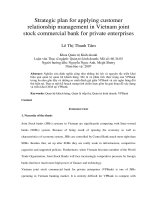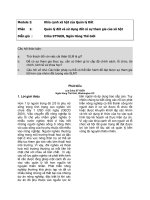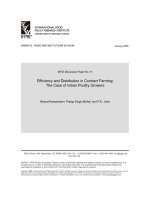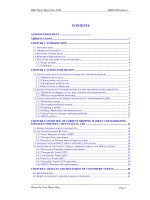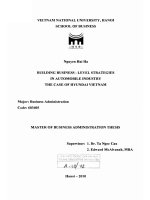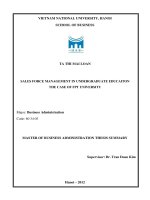Customer relationship management in securities company the case of bao viet securities company
Bạn đang xem bản rút gọn của tài liệu. Xem và tải ngay bản đầy đủ của tài liệu tại đây (1.14 MB, 71 trang )
VIETNAM NATIONAL UNIVERSITY, HANOI
SCHOOL OF BUSINESS
Nguyen Duc Hai
PRIVATE EQUITY INVESTMENT: FRAMEWORK
AND PROSPECT FOR VIETNAM
Major: Business Administration
Code: 60 34 05
MASTER OF BUSINESS ADMINISTRATION THESIS
SUPERVISORS:
DR. NGUYEN VAN DINH
HA NGUYEN, MBA
Hanoi – 2008
ACKNOWLEDGEMENTS
During my study, I have received many helps from my supervisors, my family,
my colleagues and my classmate
Firstly, I would like to express my sincerely thanks to Mr. Nguyen Hai Ha,
Mekong Capital’ ex-investment manager, and my boss now, for his suggestions
and supports. I also would like to thank to other colleagues at Vietnam Equity
Holding fund for their advices and contributions to my thesis.
To my supervisors, I would like to give my deeply thanks to Mr. Ha Nguyen for
his time to instruct me and give me valuable suggestions. I also would like to
offer my special thanks to Dr. Nguyen Van Dinh for his encouragement to
complete the thesis. I also would like to thank Ms. Nguyen Hong Ha, Ms.
Nguyen Thu Trang and others HSB faculty members for their helps and
supports.
Finally, I would like to send my heartfelt thanks to my family members, my
classmates for their supports and encouragements.
i
ABSTRACT
PRIVATE EQUITY FUND: FRAMEWORK AND PROSPECT FOR VIETNAM
Nguyen Duc Hai
MBA Candidate, 2005 – 2007
School of Business
Vietnam National University, Hanoi
Supervisor:
Nguyen Van Dinh, Assoc.Prof.,PhD
Ha Nguyen, MBA
My thesis aims to answer the question: how Private Equity Fund invests and to
provide some frameworks & guidelines for who are interesting in this investment
vehicle.
First, the author illustrates the Private Equity industry, its structure, its
researched framework and its activities in emerging countries
Second, the thesis will study and research the fact of Private Equity industry in
Vietnam. The author also chooses Mekong Capital as a snapshot to know what a
typical private equity fund in Vietnam does and then withdraw some operational
experiences from its experts.
Third, the thesis will provide some lessons which could be applied for investing
to Private Equity in Vietnam for investment managers, who are managing fund
and considering to allocate a part of fund assets to Private Equity, investors who
are considering to invest to private equity fund.
ii
TÓM TẮT
QUỸ ĐẦU TƯ TƯ NHẤN: CẤU TRÚC KHUNG VÀ TRIỂN VỌNG CHO THỊ
TRƯỜNG VIỆT NAM
Nguyễn Đức Hải
Khoa Quản trị kinh doanh – Đại học Quốc gia Hà nội
Người hướng dẫn:
PGS.TS Nguyễn Văn Định
ThS. Hà Nguyên
Tháng 10 năm 2008, 70 trang
Luận văn này nhằm giải đáp cho câu hỏi: quỹ đầu tư tư nhân đầu tư như thế nào
và cung cấp một vài khung và một số chỉ dẫn cho những ai quan tâm tới loại
hình đầu tư này.
Đầu tiên, tác giả mô tả minh họa về ngành đầu tư tư nhân, cấu trúc, các nghiên
cứu khung và các hoạt động của nó ở các thị trường mới nổi.
Sau đó, bài viết sẽ tiến hành nghiên cứu thực tế về ngành quản lý đầu tư tư nhân
ở Việt nam. Người viết cũng chọn Mekong capital làm một bức tranh cụ thể để
nghiên cứu và rút ra thêm các bài học kinh nghiệm về quản lý quỹ đầu tư tư nhân
ở Việt nam
Cuối cùng, bài viết sẽ liệt kê một số bài học có thể ứng dụng cho loại hình đầu tư
tư nhân ở Việt nam cho các nhà quản lý đầu tư, những người đang quản lý các
quỹ đầu tư và đang có ý định đầu tư vào loại hình đầu tư tư nhân và những nhà
đầu tư, những người đang muốn đầu tư vào các quỹ đầu tư tư nhân.
iii
TABLE OF CONTENTS
ACKNOWLEDGEMENTS ................................................................................... i
ABSTRACT .......................................................................................................... ii
TÓM TẮT .............................................................................................................iii
LIST OF ABBREVIATIONS .............................................................................. vi
LIST OF TABLES ............................................................................................... vii
LIST OF FIGURES ............................................................................................viii
INTRODUCTION ................................................................................................. 1
1.
The problems ................................................................................................ 1
2.
Objectives and Aims ..................................................................................... 1
3.
Research questions ....................................................................................... 1
4.
Scope of work ............................................................................................... 2
5.
Data sources .................................................................................................. 2
6.
Methods ........................................................................................................ 2
7.
Significance .................................................................................................. 3
8.
Limitation ..................................................................................................... 3
9.
Expected results ............................................................................................ 3
10.
Outline ....................................................................................................... 3
CHAPTER 1 – LITERATURE REVIEW ............................................................. 5
1.1 The concept of private equity .................................................................... 5
1.2 Type of Private Equity............................................................................... 6
1.2.1 Venture Capital ................................................................................... 7
1.2.2 Buyout ................................................................................................. 7
1.3 Investing Structure..................................................................................... 9
1.4 Size ranking ............................................................................................. 11
iv
1.5 Private Equity Performance ..................................................................... 12
1.5.1 J-curve ............................................................................................... 12
1.5.2 Expected return ................................................................................. 12
1.5.3 Real IRR of Private Equity ............................................................... 13
1.6 Private Equity in emerging market .......................................................... 15
1.6.1 Private equity in investment pools .................................................... 15
1.6.2 Emerging market ............................................................................... 17
CHAPTER 2 –PRIVATE EQUITY IN VIETNAM ............................................ 23
2.1 Vietnam Investment Context ................................................................... 23
2.1.1 Robust growth rate ............................................................................ 23
2.1.2 Bright prospective ............................................................................. 24
2.1.3 Young and grow labor force ............................................................. 25
2.2 Private Equity in Vietnam ....................................................................... 26
2.2.1 Investment fund industry................................................................... 26
2.2.2 Private equity market snapshot ......................................................... 30
2.2.3 Mekong Capital ................................................................................. 33
CHAPTER 3 –LESSONS FOR PRIVATE EQUITY INVESTMENT IN
VIETNAM ........................................................................................................... 47
3.1 Lessons from natural characteristic of private equity investment ............. 47
3.2 Lessons for investors who are considering allocate his assets to private
equity funds ....................................................................................................... 48
3.3 Lesson for fund managers who are considering allocate his fund capital to
private equity..................................................................................................... 51
BIBLIOGRAPHY ................................................................................................ 56
APPENDIX .......................................................................................................... 58
v
LIST OF ABBREVIATIONS
PEI
Private Equity Investment
EVCA
EVCA - European Private Equity and Venture Capital
Association was established in 1983 and is based in
Brussels. EVCA represents the European private equity
sector and promotes the asset class both within Europe and
throughout the world
EMPEA
EMPEA - Emerging Markets Private Equity Association.
EMPEA is a broad-based membership organization founded
in 2004 to focus on the emerging private equity markets of
Africa, Asia, Central and Eastern Europe, Russia, Latin
America, the Middle East, and Russia. EMPEA is comprised
primarily of private equity fund managers, but also includes
institutional investors, service providers and others with an
interest in the asset class.
EM
Emerging market
CEE
Central and Eastern Europe
IRR
Internal rate of return
vi
LIST OF TABLES
Table 1-1 Beta, Standard deviation and Expected return .................................... 12
Table 1-2 Growth in Fund Raised 2005 - 2007 ................................................... 17
Table 1-3 Distribution of Fund sizes for Funds with final closes in 2007 .......... 18
Table 2-1 Mekong's typical investee companies ................................................. 39
Table 4-1. Investment Fund results ...................................................................... 61
vii
LIST OF FIGURES
Figure 1.1 Venture Investment Stages ................................................................... 7
Figure 1.2 An Overview of alternative investment ................................................ 9
Figure 1.3. Principal means of investing in Private Equity ................................... 9
Figure 1.4. The J-curve ........................................................................................ 12
Figure 1.5. Private Equity performance ............................................................... 14
Figure 1.6. Performance of upper and lower quartile .......................................... 15
Figure 1.7. Total investable Capital market- December, 2006 ............................ 16
Figure 1.8 Emerging markets Private Equity Fundraising Totals, 2003-2007 .... 17
Figure 1.9 Stage of funds with final closes in 2007............................................. 19
Figure 1.10 Sector focus among funds with closes in 2007 ................................ 20
Figure 1.11 Distribution of EM PE Fundraising by Region, 2003 - 2007 ($US
mn) ....................................................................................................................... 21
Figure 1.12 Emerging markets private equity fundraising totals by region, 2003 2007 ($US mn) ..................................................................................................... 21
Figure 1.13 Fundraising by country ..................................................................... 22
Figure 2.1. The real GDP growth in 2006 ........................................................... 23
Figure 2.2. Growth rate compare ......................................................................... 24
Figure 2.3 GDP & inflation rate........................................................................... 25
Figure 2.4. Population growth.............................................................................. 25
Figure 2.5. Vietnam's Demographic structure (% total population) .................... 26
Figure 2.6 Fundraising in Vietnam ...................................................................... 28
Figure 2.7 Fund type & strategy .......................................................................... 28
Figure 2.8 Private equity fundraising in Vietnam ................................................ 31
viii
Figure 2.9 Mekong Fundraising, 2002 - 2007 ..................................................... 33
Figure 2.10 Mekong enterprise fund performance, 2002 - 1H2008 .................... 36
Figure 2.11 Mekong Enterprise Fund, % capital allocation stage ....................... 37
ix
INTRODUCTION
1. The problems
Private Equity is a broad and complex asset class within the Alternative
Investments. Its market is structured with specialized Private Equity funds.
The investments in Private Equity are still fresh and attractive investment tool
in Vietnam but are strongly developing in emerging market like China,
Thailand, and Indonesia...etc. The recent development in Vietnam stock
market lead Private Equity Investment (PEI) is on the demand of many
investors. Therefore in that context, the question of how Private Equity
invests need be answered.
This thesis aim to study how to invest in Private Equity and outline some
principals of PEI for investor
2. Objectives and Aims
The objectives of this thesis is to study
• The basic concept of Private Equity Investment
• The fact of private equity investment in emerging market and Vietnam
• Opportunity and principal guidelines to invest in PEI for investors
With these above objectives, this thesis aims at giving a basic theoretical
foundation for investors who are now considering in Private Equity
Investment and then study the fact of operation of PEI in emerging market
and Vietnam market.
3. Research questions
The complete list of research questions is as follows:
1
• What are definitions, types, common features of Private Equity?
• What are steps in Private Equity Investment?
• How did PEI perform?
• Describe the PEI industry and give a case study?
• What are withdrew lessons for fund managers and investors?
4. Scope of work
For the literature review, this thesis will study the PEI theory and inherit some
researches from some top scholars in this industry.
For the fact research, this thesis will study and describe the PEI industry
through study its associations operation reports and also inherit research
results from some institutions who deeply study about this Private Equity
Industry.
5. Data sources
For the theoretical part, data sources are textbooks, articles from internet. As
for the fact, the data sources are mainly from some PEI associations’ reports.
For the case Mekong capital, the figure and lesson are withdrawn from
management interview.
6. Methods
The thesis uses the empirical method, case study in the study process. It also
use interview as a qualitative investigation.
Choice of interviewees: The choice of interviewees was a rigid process and
very important since if the interviewee does not hold the right knowledge the
entire thesis might end up useless. The author chooses some investment
2
managers who are experience in private equity investment industry for
interviewing.
Interview structure: The two longer interviews were conducted in a
qualitative manner, but with somewhat specific questions and make sure that
every topic of interest was treated the interviewer followed a manual with the
key subjects.
7. Significance
The thesis may contribute a small part to the development of investment
industry, which has been emerging in Vietnam. Since the investment industry
is booming in Vietnam in recent two years, many investors can implement the
knowledge studied in this thesis for their business activities.
8. Limitation
The biggest limitation of this thesis is due to the freshness of Private Equity
Investment in Vietnam, so few academicals reviews have been applied and
proved.
The other limit is from case study method. This method cannot cover all the
theoretical issues of Private Equity Investment. Thus, later this case, this
thesis only studies the overall performance of PEI.
9. Expected results
The thesis expects to give the systematical theory in Private Equity
Investment, and give some principals guideline for investors.
10. Outline
Excluding introduction, conclusion and reference part, this thesis includes
three parts as follows:
3
CHAPTER 1 – LITERATURE REVIEW
CHAPTER 2 –PRIVATE EQUITY
CHAPTER 3 – LESSONS FOR PRIVATE EQUITY INVESTMENT IN
VIETNAM
4
1. CHAPTER 1 – LITERATURE REVIEW
We start this paper by looking at the Private Equity asset class. First, we give
a definition, type and investing structure in Private Equity. Then, we look at
some research result of its performance. Finally, we will see how it impact in
emerging market.
1.1 The concept of private equity
Private equity is a small part of the investment world, but is growing strongly.
After a sharp decline in capital committed following the bursting of the
telecommunications and technology bubble, private equity has seen an
increase in capital commitments in recent periods. The definition of private
equity is as follows:1
• A form of financing that typically entails entrepreneurial funding,
business expansion, business acquisitions, balance sheet restructuring
or the privatizing of a public company
• Conducted generally outside the public securities markets
• Encompasses a profit participation by the general partner
• Often comes in the form of a limited partnership
The definition of private equity illustrates that the asset class is very different
than marketable securities. Due to this fact, there are certain risks and
considerations that need to be evaluated before an investment is made, and on
an on-going basis after an allocation has been implemented.
- Illiquidity – Commitments to private market investments are usually in
the form of limited partnerships, with terms of 10 or more years. There
1
Source: VentureXpert definition
5
are no markets for these partnership interests and they cannot be
liquidated or easily transferred. This is a true long-term commitment.
- Volatility is Understated – Because most assets are valued at cost
until a measurable event occurs, private capital investments appear to
be more stable in price than they actually are. In addition, management
fees and some losses are recognized early. This gives rise to the “J
curve effect.”
- Results Dependent on Management – The ultimate level of returns
received by investors is highly dependent on the skill of the fund-offunds manager and their access to good investment partnerships.
- Time Commitment – The amount of time Committees, Staff and
Consultants must spend in monitoring private capital investments is
significantly greater than with other asset classes. Cost and complexity
multiply over time.
- Information Flows – Reports and performance data are available on
only a quarterly basis and are usually lagged by a minimum of 60 days.
Returns are calculated on an IRR basis and there are no passive
benchmarks against which you can compare results.
- Cash Flows – Are complex to manage and capital calls often have
short notification periods and must be fulfilled on a timely basis.
1.2 Type of Private Equity
There are two types of Private Equity: Venture Capital and Buyout.
6
1.2.1 Venture Capital
Venture represents investment in unquoted companies that are expected to go
public. This is what we mean by Private Equity in general. We have 4
subcategories in the Venture market:
Figure 1.1 Venture Investment Stages
Venture companies lack tangible assets that can be used as collateral for loan
and thus their access to debt financing is very limited. Investments in Private
Equity are staged, so that the investor keeps the option to abandon the project
at each milestone and limits his risks.
1.2.2 Buyout
Buyout represents investment that puts in public companies or their divisions
which may want to go private. A Buyout is, for instance, the purchase of
shares of public companies by an external investor with the aim of taking a
7
controlling interest in that firm. Buyout firms generally use a combination of
their own funds and debt to pay for takeover.
- In a Leveraged Buyout, the acquirer takes out loans or bonds in the
target’s name in order to get better financing conditions from the
lenders and uses the cash flow of the acquired company to pay them
back. It then seeks to improve performance by cutting expenses and
usually sells the target company, often through initial public offering,
within five years approximately.
- Management Buyouts follow the same goal, where a part of the
managers of company raise funds to take control of it.
The difference between these two sectors of Private Equity is that Venture
capital is invested to take a minor interest, while Buyout is to buy the firm or
to take control of it. Buyouts are less risky because the company is mature, its
stock is publicly traded and also because it has a historical performance. Also,
the publicly traded stock makes exit strategies easier. The term “exit” is the
means by which a Private Equity investor is able to realize its investment in a
company -by an initial public offering, a trade sale, selling to another Private
Equity firm or a company buy-back. Private Equity is a particular asset class
in the category of Alternative Investments, as shown in this Figure below. The
name is “Alternative Investments” as opposed to “Traditional Investments”
which refer to stocks and bonds.
8
Figure 1.2 An Overview of alternative investment
1.3 Investing Structure
There are three ways of investing in Private Equity as shown in Figure 1.3.
Principal means of investing in Private Equity. An investor can:
1 Directly invest in private companies.
2 Invest in a Private Equity fund who will then choose in which
companies to invest in and how much.
3 Invest in a fund of funds who will then invest in Private Equity funds.
Figure 1.3. Principal means of investing in Private Equity
Private Equity funds take in general the form of Limited Partnerships. The
investment manager of a Limited Partnership is called the General Partner or
Venture Capitalist, whereas the members of the Limited Partnership are the
9
Limited Partners. The General Partner's main tasks are to conduct due
diligence, to structure financial contracts, to monitor investments, to provide
resources for portfolio firms and to build in exit strategies for investors.
Private Equity funds can specialize themselves by industry, geography, stage
of financing or size of companies invested.
In such a governance structure, there is a moral hazard problem which results
from the asymmetric information between the Limited Partners and the
manager of the fund. The manager's compensation should be set up so as to
give him the right incentive. The General Partner has a fixed salary around
1% of the committed capital plus a share of the fund's performance which is
generally 20% and is called the carried interest. A Private Equity fund charges
in general a fee between 0.75% and 1.25%.
When selecting an investment, the manager faces an adverse selection
problem since he doesn't know which firms are performing well and which
are not. So, his ability to select the right investment will be crucial for the
fund's performance. One way to lower the asymmetry of information in the
Private Equity market is the due diligence made by each firm who demands
financing.
The funds of funds, instead of investing directly in companies, invest in other
Private Equity funds. This enables the investor to have a wide exposure on the
sector and, thus, offers more diversification with cost effectiveness. A fund of
funds may also be attractive to an individual, because some Private Equity
funds may be closed to them. Due to its large investment size, a fund of funds
is a preferred source of financing for Private Equity funds, since they do not
have to deal with a large number of small investors.
10
A fund of funds charges a management fee between 0.75% and 1.25% p.a.
over the Private Equity fund usual fee. For an investor, the trade-off is
between investing in a fund of funds and doing his own Private Equity
allocation. Here, the key variable for the decision is the size of the investment.
The direct investment strategy is not advisable for non-professional investors.
As we said before, there is a strong asymmetry in information and thus,
careful study of each company is needed for a sound investment. For an
individual investor desiring to invest in Private Equity to diversify its
portfolio for example, we would recommend him to invest in a fund of funds.
1.4 Size ranking
In the venture universe the fund size ranges termed small, medium, large and
mega correspond to capitalization amounts as follows2:
Venture
Small 0-25 $Mill
Medium 25-50 $Mill
Large 50-100 $Mill
Mega 100 $Mill+
Private Equity buyout
Small 0-250 $Mill
Medium 250-500 $Mill
Large 500-1,000 $Mill
Mega 1,000 $Mill+
2
VentureXpert Glossary
11
1.5 Private Equity Performance
1.5.1 J-curve
The investment in Private Equity is not done at once like for a classic stock.
The investor has generally a negative cash-flow during the first years of the
investment and then starts to get his return. This is illustrated in Figure 1.4.
The J-curve.
Figure 1.4. The J-curve
1.5.2 Expected return
An independent research of Ennisknupp showed that the expected return of
Private Equity is excess all other investment types but following by the
highest beta and standard deviation.
Table 1-1 Beta, Standard deviation and Expected return
Asset class
US Equity
expected standard expected
arithmetic deviation compounded/
Geometric
return
return
1.75
8.3
16.2
7.0
Beta with
respect to
world market
12
Non US Equity
1.77
8.4
18.3
6.7
US bonds
0.39
5.2
6.6
5.0
Core real estate
0.68
7.3
11.7
6.6
Private equity
2.83
13.7
30.2
9.2
[Source: Ennisknupp, updated July 2008 - ENNISKNUPP capital markets modeling
assumption, page 5]
The expected compounded/geometric return is the relevant assumption from
the point of view of a long term investor. It is the return that the asset will
experience over the long-term. The geometric average return is lower than the
arithmetic average return whenever there is uncertainty (which is measured by
standard deviation) in annual returns.
Additionally, to account for the expected return compensation from
investments on private markets, the arithmetic expected return for private
equity is adjusted upward from 10.7% (based on the Global CAPM) to 13.7%.
Consequently, the compounded/geometric return for private equity would
increase from 6.2% to 9.2%. The 3% represents common industry expectation
for the additional return provided by private equity investments over public
equity.
1.5.3 Real IRR of Private Equity
The generally adopted measure is the Internal Rate of Return (IRR) based on
the cash inflows and outflows and the final net asset value, although we know
that this measure is not relevant in some cases. For this measure to work
properly, the exact timing of the investments has to be known. Obtaining this
data is a difficult task, since the general sources like Venture Economics or
the EVCA provide them only at an aggregate level.
13
Figure 1.5. Private Equity performance
[Source: Ludovic Phalippou and Maurizio Zollo, 2005 - The Performance of Private
Equity Funds, page 11]
In Figure 1.5. Private Equity performance, we see the recent returns of Private
Equity and the global impact of the Internet bubble which decreased the 3
year All Private Equity IRR to -2.3 % and 5 year to only 1.9%. The returns
are particularly low, especially for the Early Stage which is the riskier
category.
As we will see in the following, Private Equity is a long term investment, not
only because a fund is created for 10 years on average but also because excess
return is obtained only after 10 years. This is why, when we look at Private
Equity returns, we generally consider the 10-year return, which is 9.8% in our
case.
The choice of top quartile fund managers is particularly important in Private
Equity. The spread observed between good and bad managers is significantly
higher in Private Equity than in quoted equity or bonds. There is a 15%
difference in returns from the lower to upper quartile, whereas this spread is
about 1% for bond fund managers and 3% for public equities. Moreover, a top
14
quartile fund manager tends to keep having the best returns. As we can see in
Figure 1.6. Performance of upper and lower quartile, access to top
partnerships is critical.
Figure 1.6. Performance of upper and lower quartile
[Source: Ludovic Phalippou and Maurizio Zollo, 2005 - The Performance of Private
Equity Funds, page 15]
We see in Figure 1.6. Performance of upper and lower quartile that the lower
quartile had returns lower than the US T-Bill. Thus, when building a portfolio
of Private Equity, not only should we consider the weights of our allocation
but also the choice of best fund managers.
1.6 Private Equity in emerging market
1.6.1 Private equity in investment pools
The Private Equity is a small asset class: Private equity constitutes less than
1% of the opportunity set. The graph below shows what portion of the
investable universe private equity, and other asset classes, represents.
15
